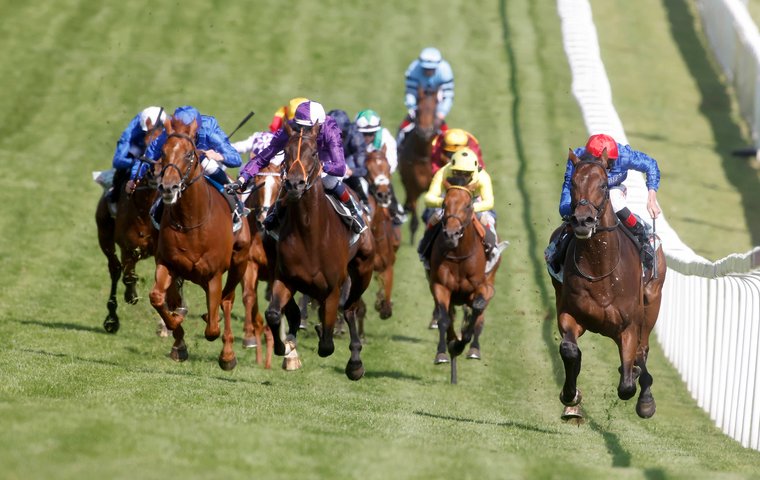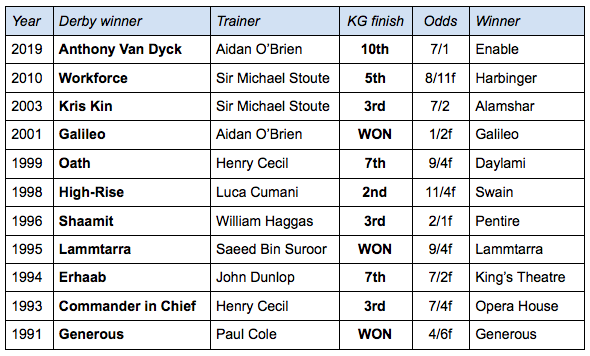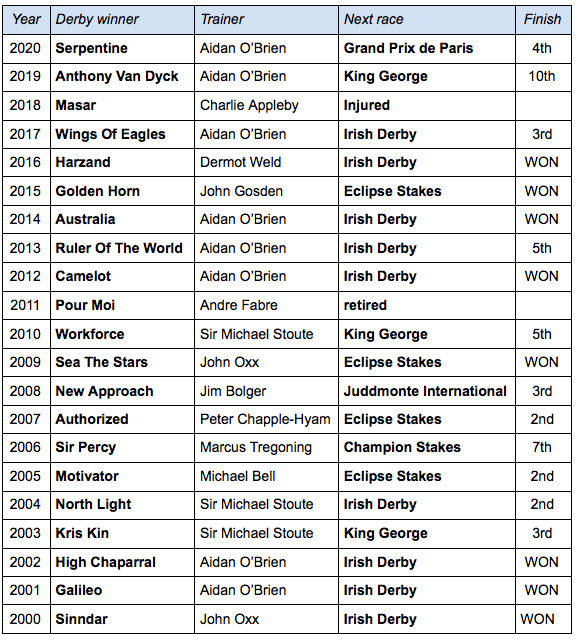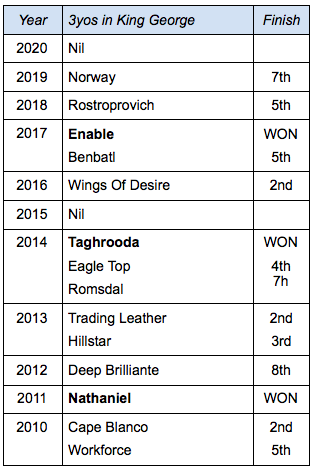
In many ways, the presence of Derby winner Adayar in Saturday’s King George VI and Queen Elizabeth Stakes represents a throwback, a return to the glory years when Ascot’s midsummer showpiece was almost a compulsory attraction for any Epsom hero.
In many ways, the presence of Derby winner Adayar in Saturday’s King George VI and Queen Elizabeth Stakes represents a throwback, a return to the glory years when Ascot’s midsummer showpiece was almost a compulsory attraction for any Epsom hero.
Inaugurated for the Festival of Britain in 1951, the King George was created to provide a middle-distance clash of the generations, almost a summer version of Europe’s most valuable race, the Prix de l’Arc de Triomphe.
Unsurprisingly, the roll of honour reads like an equine who’s who, featuring some of the most highly acclaimed horses in racing history – among them no fewer than 13 colts who have won the Derby and King George in the same season, starting with Tulyar and Pinza in 1952 and 1953. Their successors in doing the famous double include a plethora of the sport’s biggest names such as Nijinsky, Mill Reef, Grundy, Shergar, Nashwan and Galileo. Two more, Royal Palace and Teenoso, scored at Ascot the year after winning Britain’s senior Classic.
However, that was then but this is now. No Derby winner has landed the King George since the late, lamented Galileo beat Fantastic Light in an epic encounter in 2001 (see video below) en route to his legendary stud career.
In fact, only four Derby winners – Kris Kin, Workforce and Anthony Van Dyck are the other three – have even run at Ascot since the turn of the century, reflective of a wider trend that has seen 3-year-old contenders diminish.
Galileo was the first 3-year-old to win the King George since fellow Derby winner Lammtarra in 1995. There have been four since: Alamshar (2003), Nathaniel (2011) and the Oaks winners Taghrooda (2014) and Enable (2017).
DERBY WINNERS IN THE KING GEORGE SINCE 1990
WHERE THE DERBY WINNER WENT
That brings the total number of 3-year-old winners altogether to 30, compared to 40 older horses (30 4-year-olds, eight 5-year-olds, and two 6-year-olds - in Swain and Enable).
 In the first 50 runnings before 2000, more than 50 percent of winners had come from the Classic generation. Yet their numbers have dwindled to the extent that, since 2010, only 15 of the 83 horses to have contested the King George have been 3-year-olds. That’s just over 18 percent.
In the first 50 runnings before 2000, more than 50 percent of winners had come from the Classic generation. Yet their numbers have dwindled to the extent that, since 2010, only 15 of the 83 horses to have contested the King George have been 3-year-olds. That’s just over 18 percent.
Nick Smith, Ascot’s director of racing and public affairs, noted the trend as long ago as 2009. “The raison d’être of the King George is to be a spectacular midsummer showdown between the best older horses and the best 3-year-olds,” he told The Guardian then. “And at the moment, it’s not delivering.”
Fast forward to 2021 and Smith is rather more sanguine about the Qipco-sponsored contest’s enduring status. “There was certainly a period after the millennium when it wasn’t that race, and what I said then was reflective of where the race was,” he told TRC. “In recent years, it’s probably fair to say it is delivering that aspiration.”
As such, Adayar’s participation can be regarded only as a positive, though Smith points out the obsession with the Derby winner can be misleading. “Obviously it’s good news to have the Derby winner, but I think people over-inflate that point,” he says.
“It comes up every year whether the Derby winner runs or not, but Anthony Van Dyck ran fairly recently and Taghrooda and Enable were Oaks winners who won the King George, so it surprises me that the Derby winner question is raised in isolation.
“Golden Horn was in the stable to run in the King George but was prevented from doing so owing to a last-minute deluge making ground very soft. It’s not as if trainers of top 3-year-olds aren’t looking at the King George; a fair amount of horses who are considered good enough to run in King George do run in the King George.”
That said, Smith is realistic enough to appreciate that a return to the zenith of the race’s halcyon era is an unlikely prospect. “The world has changed,” he says emphatically. “It will never be what it was when it was the overwhelming target because it was the only race.
“We’re never going to go back to the 1990s, because the world has moved on and so many opportunities are open to horses. That’s a wider issue than the King George with regard to field sizes and the inflation of the pattern.
“There are simply too many options to expect them all to come together in the way that used to be the norm. The expansion of the autumn Pattern domestically and internationally just means horses simply will not run against each other. It’s an irreversible fact.”
On the other hand, Smith plays down the suggestion that mile-and-a-quarter races are tempting horses elsewhere, a G1 victory at that distance being considered a major plus with the breeding shed in mind.
“It has been a factor, but I don’t feel it’s as overwhelming a factor with regard to the King George as it used to be,” he says. “Five or ten years ago it was an overwhelming priority, but the fact the Derby has reigned supreme throughout all this period does rather indicate that the mile-and-a-half category is still vital.”
Prize money aspiration
Are other factors at play? What about prize money, for example? At its zenith, the King George was worth £1.25 million – not an audacious amount in global terms, but pretty substantial for Britain. After last year’s Covid-denuded purse of £400,000, the pot is back up to a respectable £875,000.
“In the current climate it’s good prize money domestically, but that is quite important to us,” says Smith. “We would like the King George to be the most valuable midsummer race in Britain — that’s a fair aspiration. It was that, and we’ll try to build back to that.”
Even so, prize money is unlikely to be increased enough to make a substantive difference to the shape of the field. “We want to take increases incrementally but, in order to have a real game-changer, you’d probably be talking about tripling it, which isn’t practical.
“But there is a wider issue about the struggle to get horses from France and wider afield. Domestically, the King George is always in or around the biggest races, so I don’t think prize money is a detrimental factor, but it does make it harder promoting races overseas.”
In a sense, Smith suggests the King George receives greater scrutiny because of its success over the decades – and its obvious popularity down the years. “I honestly believe there isn’t a race on the calendar that gets analysed as much as the King George,” he says. (Guilty as charged.)
“It’s because people love it so much and would love it to be what it was in late 80s and early 90s, but it’s peaks and troughs. You can’t have a definitive championship in midsummer, but the King George can still be the definitive race of the year sometimes. In a good year, like when Enable beat Crystal Ocean, it gets lavished with praise, in a less competitive year, it gets questioned.”
Smith goes on to point out the dichotomy between last year’s uncompetitive 3-runner contest and a potential thriller this weekend featuring three of the world’s top 12 horses in the TRC Global Rankings - Love (currently world #6), Mishriff (#9), and possibly #12 Wonderful Tonight- as well as Adayar and another top 3-year-old, Irish Derby runner-up Lone Eagle.
“Usually a relatively poor year is followed by a good year,” he says. “Last year was a freak scenario, but there’s no material reason why this year’s race should be so different. Yet you’ll see a Derby winner, a Prince of Wales’s Stakes winner and maybe Mishriff, who ran in the Eclipse [and won the Saudi Cup and Dubai Sheema Classic]. You’d probably have Addeybb but for the ground and you’d probably have an Irish Derby winner in Hurricane Lane if Charlie Appleby didn’t have Adayar.
“If you’d come out of a coma having watched Generous win the King George in 1991 and saw this one, you’d think nothing had changed.”


